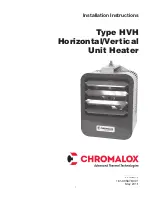
13
Troubleshooting
Problem
Probable Cause
Solution
Unit will not turn on
Thermostat set point too low.
Turn dial in clockwise direction to increase tem-
perature set point.
Improper or loose wire
connections.
Check control and power circuit to make sure
they are wired properly and for any loose wire
connections.
Disconnect switch in off position.
Make sure disconnect switch is in “on” position
by turning it in the clockwise direction.
Tripped circuit breaker or blown
fusing (located remotely from unit).
Check to see if circuit breaker has been tripped
or replace fusing.
Blown internal fusing (located on
units rated above 48 amps).
Replace fusing as needed.
Unit not producing heat Thermostat set point too low.
Turn dial in clockwise direction to increase tem-
perature set point.
Summer fan switch is set to
“Summer” mode or wired incor-
rectly
If a summer fan switch is installed, check to
make sure it is switched to the “Winter” setting.
Check to make sure wires on switch are not
reversed.
Element Failure
Element failure can be confirmed by performing
a continuity test or by measuring the elements
resistance.
Unit turns off suddenly
or cycles off before
reaching temperature
set point
Low airflow is causing automatic
reset temperature cutout on ele-
ments to activate.
There are several reasons for low airflow and
most of them can be easily corrected.
• The first reason for low airflow is stratification
of the air in a room. This can cause the ambi-
ent temperature around the heater to exceed
the maximum rated operating temperature.
The problem can usually be solved by mount-
ing the heater at a lower height.
• Low airflow can also be caused by incorrect
rotation of the fan. Check that the fan motor is
rotating in the counterclockwise direction.
• Finally, a common solution for low airflow is to
remove any objects located too close to the
inlet or outlet.
Low airflow is causing motor ther-
mal cutout to activate.
Figure 17:
Control Panel
Summary of Contents for HVH Series
Page 2: ...2 ...
































